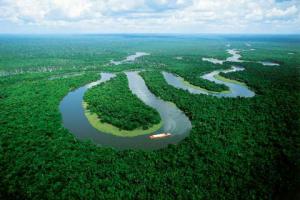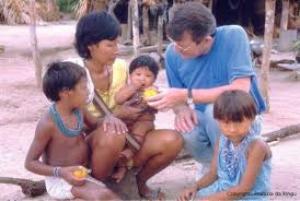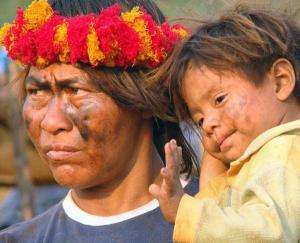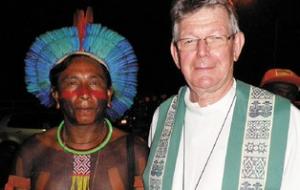The Amazon is a region with very particular characteristics. Rich in biodiversity, it is home to many different peoples with varied cultural and religious traditions whose lives are under threat from capitalism.
| AMAZONIA |
 The Amazon is a region with very particular characteristics. Rich in biodiversity, it is home to many different peoples with varied cultural and religious traditions whose lives are under threat from capitalism.
The Amazon is a region with very particular characteristics. Rich in biodiversity, it is home to many different peoples with varied cultural and religious traditions whose lives are under threat from capitalism.
Amazonia, also referred to as Pan Amazonia, is bordered by the basin of the River Amazon which has its source in the Andes in
The Amazon region has a surface area of 7.500.000 square miles and comprises 43% of the surface of
The Amazon rainforest is one of the largest on the planet and it absorbs 80 to 120 million tons of carbon per year. Therefore the conservation of the rainforest is of vital importance for our climate and for the health of the planet, and the health of humanity as a whole.
The Amazon basin was designated the Patrimony of Humankind by UNESCO in the year 2000.
 The present population of Pan-Amazonia is estimated to be around 40 million and the population can be divided in the following way:
The present population of Pan-Amazonia is estimated to be around 40 million and the population can be divided in the following way:
There are 3 million indigenous people belonging to 400 different ethnic groups with 250 different languages. The deterioration of the rainforest directly affects these original inhabitants. It is thought that at the beginning of the colonial period there were more than 5 million indigenous people from 900 different ethnic groups.
There are numerous communities of African origin and in
 There are many communities living on the coast, communities of farmers, immigrants, mixed race groups and people inhabiting the large cities of the Amazon.
There are many communities living on the coast, communities of farmers, immigrants, mixed race groups and people inhabiting the large cities of the Amazon.
Since the arrival of the colonizers, the population of the Amazon has gone through different periods:
The Colonial period: The Jesuit missionaries arrived and began evangelisation among the native populations.
The rubber period: This lasted right up to the beginnings of the XX century. The development of the automobile industry and industries dependent on rubber led to the advent of national and international companies who were set up to extract rubber from the rainforest. This industry attracted migrant workers from many regions, especially people from the
Second rubber period: During the Second World War, the
Development Projects: Several years ago the Brazilian government introduced a series of initiatives such as experiences in agriculture and the free zone of Manaos was set up. This was much criticised.
There was also an initiative to create reservations such as
At the present moment there is a project called the Integration of the Regional Infrastructure of South America. This project was approved by the presidents of the Latin American countries and agreements were signed in
This project, based on international economic interests, has been put in place to extract the wealth of the region (land, subsoil, biodiversity, water etc) and export it easily by sea. This requires the building of roads and waterways. This type of programme will bring about significant changes in the geography of the Amazon and the loss of natural resources; it will also lead to movements of peoples in search of work and will have an impact on indigenous peoples who will be ever more confined to reduced areas and their vision of the world and their relationship with Mother Earth will be violated.
These programmes show clearly how the political system is subject to economic interests. The
The Amazon rainforest, with its massive trees measuring 30 to 50 metres in height, was virgin forest until the beginnings of the XX century. Today deforestation is putting ecological balance in jeopardy.
It was not by chance that the Latin American Bishops in Aparecida recognised the wisdom of indigenous peoples in their teaching. “The Church esteems the values highlighted especially by indigenous peoples: respect for nature, love of Mother Earth as the source of sustenance and as the common home and altar where we humans learn to share”. The Bishops pledge to “raise awareness in the
In this context it is worth mentioning the prize received by Mr. D.Erwin Kraulter, one of the four winners of the Right Livelihood Prize 2010, the alternative Nobel Prize, which honours those who commit to working for change at grassroots level. D. Erwin received this prize “for a life dedicated to working for human rights and the rights of indigenous peoples and for the tireless efforts made to save the
“I am happy to receive this prize, not for my own sake but for the sake of the
_____________________________________
SOURCES
Pan-Amazônica: De “quintal” a “praça central do planeta” – Revista Convergência – Nov. 2010.
Jornal Porantin n. 328 – Set. 2010
Documento Missão na Amazônia – CNBB 2010.
Amazônia - Enciclopédia Wikipedia

